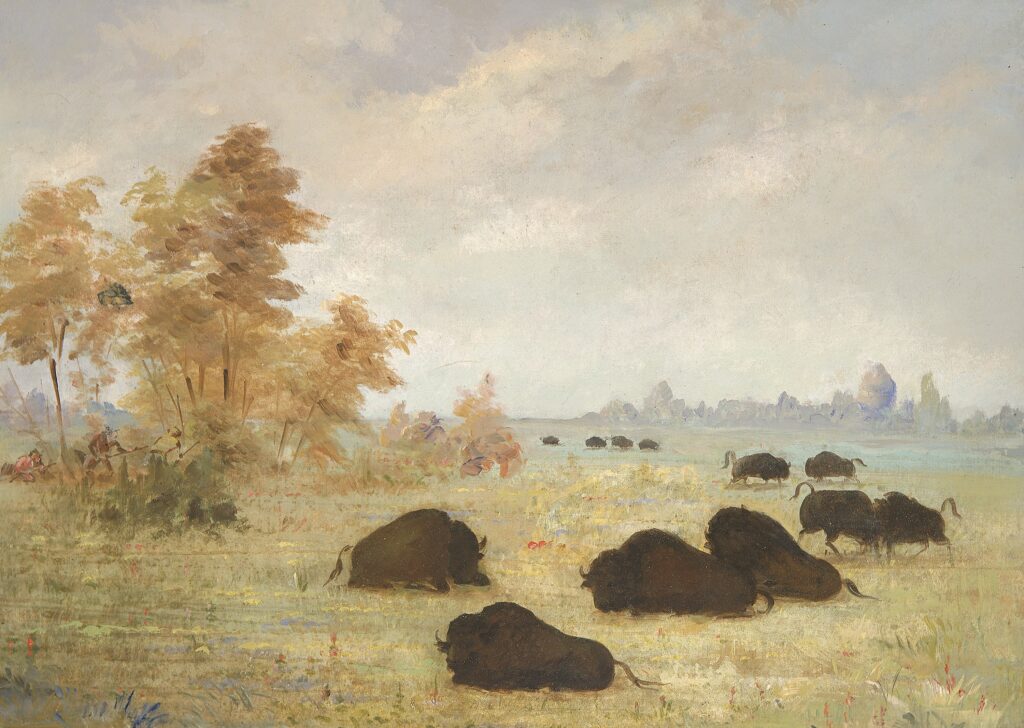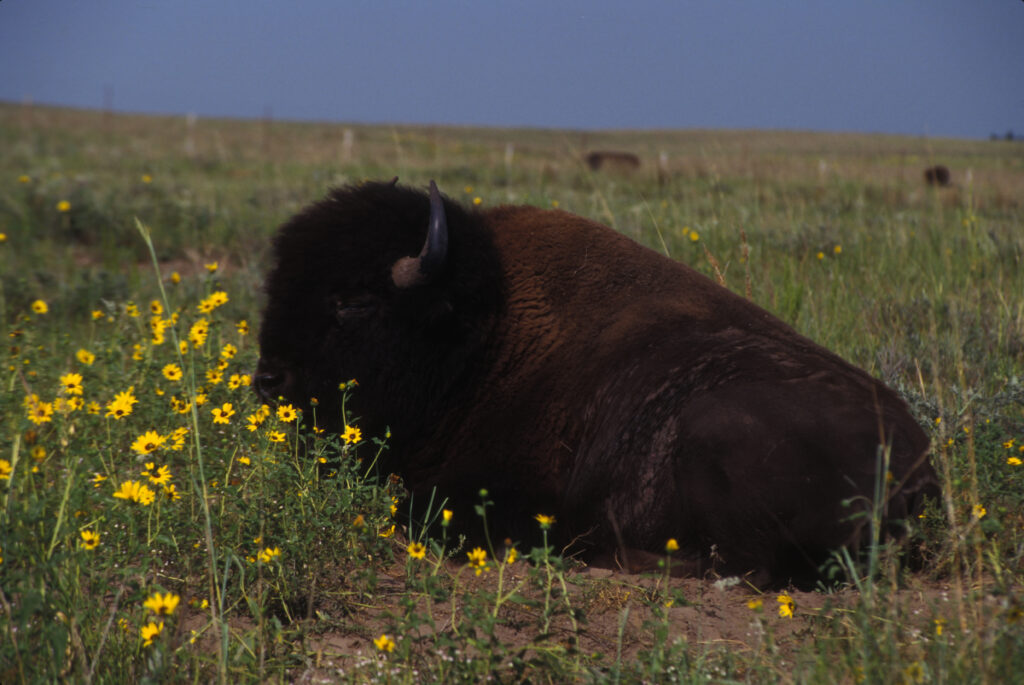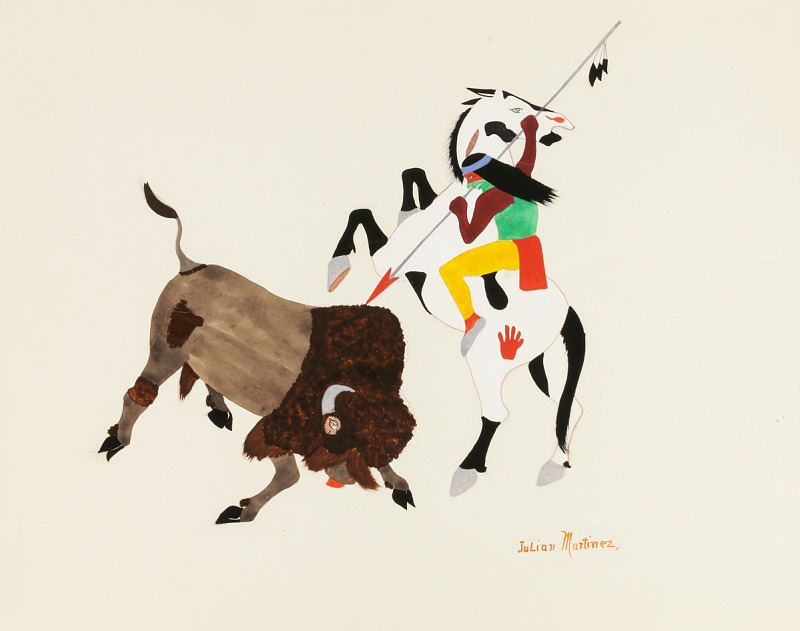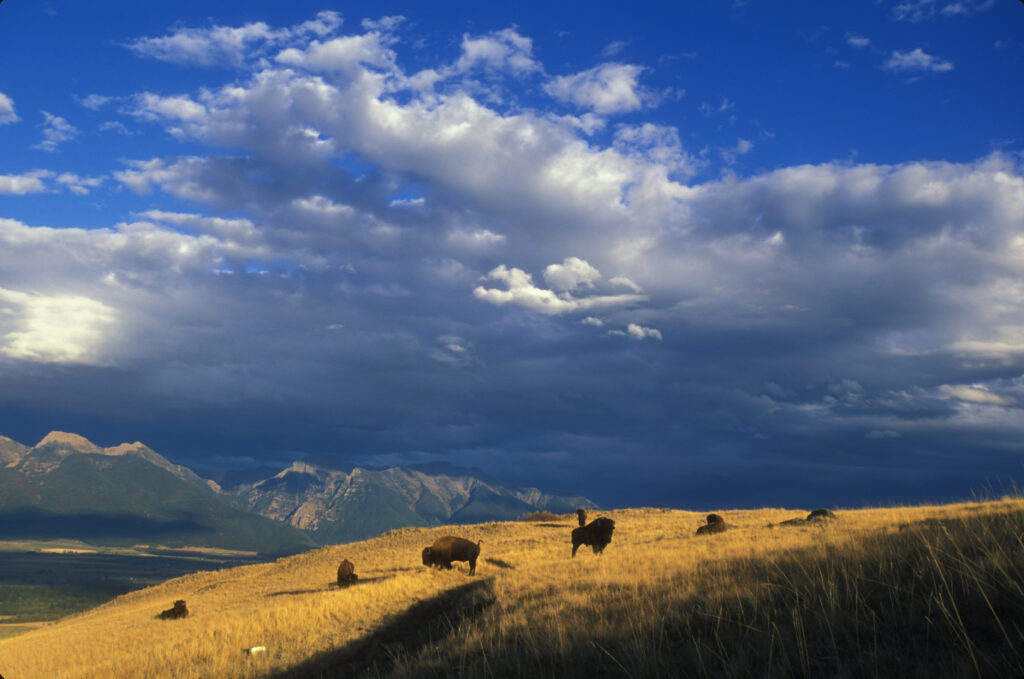Buffalo Tales of the Great Plains
Collected by Katherine Berry Judson
Annotations by Ian McLAughlin/JB

ORIGIN OF THE BUFFALO (Teton) [1]
In the days of the grandfathers, buffaloes lived under the earth. In the olden times, they say, a man who was journeying came to a hill where there were many holes in the ground. He entered one of them. When he had gone inside he found buffalo chips and buffalo tracks on all sides. He found also buffalo hairs where the buffaloes had rubbed against the walls. These were the real buffaloes and they lived under the ground. Afterwards some of them came to the surface of the earth and lived there. Then the herds on the earth increased.
These buffaloes had many lodges and there they raised their children. They did many strange things. Therefore when a man escapes being wounded by an enemy, people say he has seen the buffaloes in his dreams, and they have helped him.
Men who dream of the buffaloes act like them and dance the buffalo-bull dance. Then the man who acts the buffalo has a real buffalo inside of him, people say, a little hard ball near the shoulder blade; and therefore he is very hard to kill. No matter how often he is wounded, he does not die.
People know that the buffaloes live in earth lodges; so they never dance the buffalo dance vainly.
THE BUFFALO AND THE GRIZZLY BEAR (Omaha)
Grizzly Bear was going somewhere, following the course of a stream, and at last he went straight towards the headland. When he got in sight, Buffalo Bull was standing beneath it. Grizzly Bear retraced his steps, going again to the stream, following its course until he got beyond the headland. Then he drew near and peeped. He saw that Buffalo Bull was very lean, and standing with his head bowed, as if sluggish.
So Grizzly Bear crawled up close to him, made a rush, seized him by the hair of his head, and pulled down his head. He turned Buffalo Bull round and round, shaking him now and then, saying, “Speak! Speak! I have been coming to this place a long time, and they say you have threatened to fight me. Speak!” Then he hit Buffalo Bull on the nose with his open pa
“Why!” said Buffalo Bull, “I have never threatened to fight you, who have been coming to this country so long.”
“Not so! You have threatened to fight me.” Letting go the buffalo’s head, Grizzly Bear went around and seized him by the tail, turning him round and round. Then he left, but as he did so, he gave him a hard blow with his open paw.
“Oh! Oh! Oh! Oh! Oh! you have caused me great pain,” said Buffalo Bull. Bobtailed Grizzly Bear departed.
Buffalo Bull thought thus: “Attack him! You too have been just that sort of a person.”
Grizzly Bear knew what he was thinking, so he said, “Why! what are you saying?”
“I said nothing,” said Buffalo Bull.
Then Grizzly Bear came back. He seized Buffalo Bull by the tail, pulling him round and round. Then he seized him by the horns, pulling his head round and round. Then he seized him again by the tail and hit him again with the open paw. Again Grizzly Bear departed. And again Buffalo Bull thought as he had done before. Then Grizzly Bear came back and treated Buffalo Bull as he had before.
Buffalo Bull stepped backward, throwing his tail into the air.
“Why! Do not flee,” said Grizzly Bear.

Buffalo threw himself down, and rolled over and over. Then he continued backing, pawing the ground.
“Why! I say, do not flee,” said Grizzly Bear. When Buffalo Bull backed, making ready to attack him, Grizzly Bear thought he was scared.
Then Buffalo Bull ran towards Grizzly, puffing a great deal. When he neared him, he rushed on him. He sent Grizzly Bear flying through the air.
As Grizzly Bear came down towards the earth, Buffalo Bull caught him on his horns and threw him into the air again. When Grizzly Bear fell and lay on the ground, Buffalo Bull made at him with his horns to gore him, but just missed him. Grizzly Bear crawled away slowly, with Buffalo Bull following him step by step, thrusting at him now and then, though without striking him. When Grizzly Bear came to a cliff, he plunged over headlong, and landed in a thicket at the foot. Buffalo Bull had run so fast he could not stop at the edge where Grizzly Bear went over, but followed the cliff for some distance. Then he came back and stood with his tail partly raised. Grizzly Bear returned to the bank and peeped.
“Oh, Buffalo Bull,” said Grizzly Bear. “Let us be friends. We are very much alike in disposition.”
MY FIRST BUFFALO HUNT (Omaha)[2]

Smithsonian American Art Museum and its Renwick Gallery, Washington, D.C.
I went three times on the buffalo hunt. When I was there the first time, I was small; therefore, I did not shoot the buffaloes. But I used to take care of the pack horses for those who surrounded the herd. When they surrounded the herd at the very first, I spoke of shooting at the buffaloes. But my father said, “Perhaps the horse might throw you suddenly, and then the buffalo might gore you.” And I was in a bad humor.
My father went with me to the hill. We sat and looked on them when they attacked the buffaloes. And notwithstanding my father talked to me, I continued there without talking to him. At length one man was coming directly toward the tents in pursuit of a buffalo bull. And the buffalo bull was savage. He attacked the man now and then.
“Come! Go thither,” said my father. I tied a lariat on a large red mare that was very tall. And taking a very light gun which my father had, I went over there. When I arrived the buffalo bull was standing motionless. The man said he was very glad that I had come. The buffalo bull was savage. The man shot suddenly at him with a bow and wounded him on the back. And then he attacked us. The horse on which I was seated leaped very far four times, and had gone off, throwing me suddenly. When the buffalo bull had come very close, he wheeled around and departed. So I failed to shoot at him before he went. I reached home just as my mother was scolding my father about me. When the horse reached home with the bridle sticking to it, she knew that I had been thrown. My father said nothing at all, but sat laughing. Addressing me, he said, “Did you kill the buffalo bull?” And I did not speak.
JUDSON, KATHARINE BERRY., ED. “Origin of the buffalo,” in MYTHS AND LEGENDS OF the great plains, 53-54. A. C. McClurg & co., 1913.
JUDSON, KATHARINE BERRY., ED. “the buffalo and the grizzly bear,” IN MYTHS AND LEGENDS, 68-70.
JUDSON, KATHARINE BERRY., ED. “My first buffalo hunt,” IN MYTHS AND LEGENDS, 71-72.
[2] “The author, Frank La Flèche, an Omaha Indian, was about twelve years old when this occurred” (ed. footnote).
Contexts
Mistakenly called buffalo, the American Bison once roamed across North America in large numbers. Though we may never know how many bison were alive at their peak, experts believe they once numbered between 30 and 75 million. By 1800, the herds east of the Mississippi were killed off. By 1838, many herds in the northern and southern portions of the Great Plains were destroyed. There were only 300 wild bison by the turn of the 20th century. In 1894, Congress passed a law making it illegal to hunt bison in Yellowstone National Park. Twenty-one bison were purchased in 1902 to rebuild the Yellowstone herd. In 2019, the Yellowstone herd numbered nearly 5,000, and there were nearly 40,000 bison across North America.
The American bison is culturally important to the Native American tribes of the Great Plains region, including the Teton and Omaha tribes, from whom these stories were collected. The overhunting of the buffalo since the arrival of Europeans has had systemic effects on the land and the Native peoples.
Resources for Further Study
- The full text of Judson’s collection is available on Project Gutenberg.
- “The Sacred Hoop: A Contemporary Perspective on Native American Literature” from The Sacred Hoop: Recovering the Feminine in American Indian Traditions by Paula Gunn Allen is a great essay on how to read Native Literature as a non-Native.
- The National Park Service has information on the Yellowstone herd and bison conservation, as does Bison Range Restoration, which is in the process of transitioning oversight of the National Bison Range from U.S. Fish and Wildlife to resource managers from the Confederated Salish and Kootenai Tribes (CKST).

Contemporary Connections
There are several works of fiction regarding the Native American connection to the American Bison:
- Buffalo Dreams by Kim Doner links the traditional connection to buffalo to the present day.
- Buffalo Song by Joseph Bruchac (Abenaki) is a buffalo history: how they came to be, why they were almost killed off, and how Great Plains Natives still see them as sacred.
- The Buffalo Jump by Peter Roop describes a traditional method for hunting buffalo.
[1] Judson includes the tribal origins of each tale with the title.